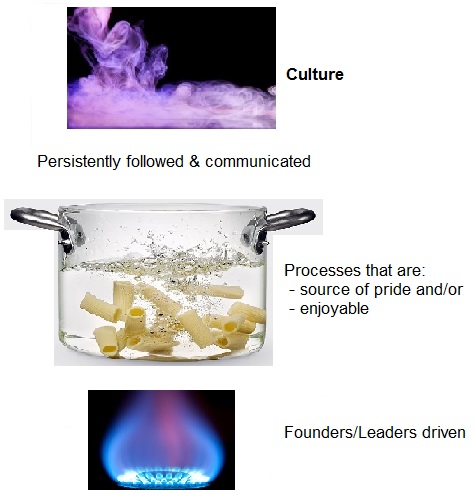‘We don’t have a culture of innovation’ is the most common reaction that one gets from leaders and managers who are not happy with the intensity of innovations in their company. There are two types of emotions behind this statement:
- An excuse to justify the low intensity of innovations. By attributing to culture, we try to shrug-off our responsibility or accountability and attribute it to the past legacy. This excuse is accepted by the internal and external audience as no-one knows how to create or build a culture of innovation. This is a negative emotion and indicates that the person is disinterested to drive innovation.
- A genuine helplessness of not being able to encourage innovation in the organization and attributing it to culture. This is a positive emotion and indicates that the person might invest time in encouraging innovations if there was a method to do so. Let me explain this in more details.
Let’s start by understanding the meaning of the word ‘culture’. If I ask you to explain your understanding about culture, the typical answer would be: ‘It is something that makes us do and say things naturally’, ‘it is the way we behave’, ‘it is the way we listen’ or ‘it is the way we treat others including employees, peers, customers and others’ etc.
Dictionary:
Following is the extraction from the dictionary for the word ‘culture’:
- The integrated pattern of human knowledge, belief, and behavior that depends upon the capacity for learning and transmitting knowledge to succeeding generations.
- The set of shared attitudes, values, goals and practices that characterizes an institution or organization.
- The set of values, conventions or social practices associated with a particular field, activity or societal characteristic.
Definition of ‘Culture’ from research:
This is how various researchers have defined ‘culture’:
- Kroeber and Kluckhorn (1952) – Culture is nothing but a set of social norms and responses that condition people’s behaviour.
- Hofstede (1980) – National culture as “collective mental programming”. Culture is an enacted system of beliefs, symbols and behaviors which binds individuals in groups.
- Sin and Tse (2000) – Patterns of shared values and beliefs developed over time, producing behavioural norms that are adopted in solving problems.
- Pierre Bourdieu (1990) – Symbolic systems that are products of practices, which are ‘coherent and compatible with the objective conditions – but also practical and easy to master and use.
Here are a few specific examples that people give to explain the cultural impediments for innovation:
- Fear of being mocked or thrashed for sharing an out of box idea
- Fear of failure leading to reluctance of people to work on innovation projects (read how fear of failure creates obstinacy and why we it important to get rid of this fear)
- Fear of producing defects while running experiments to test and implement an innovative idea (Why people need leaders’ support in driving innovations?)
- Fear of losing annual bonus or promotion for not achieving the risky innovation outcome
The above appear to be issues related to behavior, beliefs and shared values. This establishes that culture is an impediment for innovation. The larger and complex question is: ‘How does one change this culture to make it conducive for innovation?’ To answer this question, let us refer to research on how culture gets created
How is culture formed in an organisation?
The culture exists in all the societies from where people join organizations. People come with their own culture inherited from their societies that is influenced by religion, ethnicity, country and few other factors. When people from varied culture come together in an organization, the organizational culture builds over a period of time either naturally or by intent. Ben Horowitz said – Truth be told, either you can shape your own culture, or it will inevitably shape itself.
If the culture is not shaped, it naturally gets influenced by the founder and senior leaders. The action of leaders in tough situation and testing times has a huge bearing on the formation or change in the culture of organizations. It also gets influenced by people who are from similar culture and outnumber others. The prevailing culture of the industry also influences the culture of an organization.
On the other hand, if the behavior and values of senior leaders are not coherent, it results in an incoherent or disparate culture in the organization.
Can we import the culture, or we need to shape it?

Culture cannot be imported or transferred overnight in an established organization. Culture gets shaped and reshaped slowly over a long period of time. Following elements contribute in building/shaping and reshaping the culture.
- Create processes that are simple and enjoyable for people to follow. It should give benefits to people/organization. e.g. If you want to have a culture in which people fearlessly give ideas, you need to create a process, which either creates a controlled environment for sharing ideas or allows people to read only the idea without knowing the person behind the idea!
- ‘Do’ and not only ‘say’: The extent to which senior leaders themselves follow the above processes and encourage/reward others for following them is crucial for reshaping the culture. Remember, people see everything that others do and especially their seniors and leaders.
- Persistence: Culture is mostly created for the next generation. CEOs inherit culture and they need to reshape it for their successors by modifying or introducing processes and persistently following them for years. We need to persist longer for processes that effect a larger number of people and yield results over a longer period of time e.g. Safety in a hazardous factory.
- Communication: It is important for leaders to communicate why they are doing what they are doing especially if it is counter-intuitive and not aligned to the existing culture. Inspirational stories – especially those that are related to unusual situations shape the culture.
- Source of pride: If the processes or the outcomes become a source of pride for employees, it is an early indicator of a culture.
The above discussion can be summarized as
Culture is nothing but process(es) followed for years in a manner that is enjoyable and/or is a source of pride
In the next three posts I will delve deeper into the innovation culture:
Reference:
https://www.researchgate.net/post/How_is_organizational_culture_created_and_sustained

